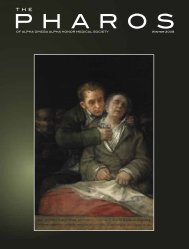4 - Alpha Omega Alpha
4 - Alpha Omega Alpha
4 - Alpha Omega Alpha
You also want an ePaper? Increase the reach of your titles
YUMPU automatically turns print PDFs into web optimized ePapers that Google loves.
est evidence for the differentiation comes from adoption<br />
studies. One sibling of alcoholic parentage adopted by a nonalcoholic<br />
family has the same risk of becoming alcoholic as a<br />
sibling (about twenty percent) reared in the alcoholic home.<br />
Children of nonalcoholics adopted by alcoholic families have<br />
a significantly higher chance of being abusive drinkers, but not<br />
of becoming alcoholic. The implication is that alcoholism is a<br />
disease with strong genetic origins, while problem drinking<br />
may be mostly determined by environmental factors. 8<br />
The likely ethanol- abusive Robert Jordan drinks more or<br />
less continuously throughout the rest of the novel. On day<br />
two, when he visits El Sordo, another guerilla leader nearby,<br />
the two talk over several whiskeys. It is not yet noon. Morning<br />
drinking, especially after a previous night of drinking, can<br />
be repugnant to healthy drinkers, but welcomed by problem<br />
drinkers and alcoholics as the best cure for a hangover and<br />
morning jitters. Later, as Pilar is getting to know Robert and<br />
inquiring about his interests, she states, “ ‘You like to drink, I<br />
know. I have seen.’ ” He responds, “ ‘Yes. Very much. But not<br />
to interfere with my work.’ ” 5p91 A problem drinker’s problem<br />
is almost invariably evident to others before it is self- evident.<br />
A moment of clarity for Robert, when he surely realizes his<br />
reliance on alcohol, comes towards the end of the novel as he<br />
lies on the ground wounded, anticipating what will likely be<br />
his own death.<br />
Then he remembered that he had the small flask in his<br />
hip pocket and he thought, I’ll take a good spot of the giant<br />
killer . . . But the flask was not there when he felt for it.<br />
Then he felt that much more alone because he knew there<br />
was not going to be even that. I guess I’d counted on that,<br />
he said. 5p467<br />
In contradistinction to Robert and Pablo, Pilar exemplifies<br />
the normal, healthy drinker. In the initial scene at the cave,<br />
when Robert offers her a cup of wine, she declines, “ ‘Not until<br />
dinner,’ she said. ‘It gives me heartburn.’ ” 5p32 The next morning,<br />
when offered whiskey: “ ‘I don’t want any,’ Pilar said and<br />
covered her glass with her hand.” 5p142 Then, offered wine instead,<br />
she answers, “ ‘No. Water.’ ” 5p142 Pilar does enjoy a glass<br />
of wine with food, and in her stories she reminisces on the<br />
delight of a cold beer in the afternoon, but during the novel<br />
she never has more than two drinks at a time and possesses<br />
the ability to take it or leave it without much thought or worry,<br />
the hallmark of the normal drinker.<br />
Alcoholism—Genetic pathways<br />
in the brain<br />
The “Big Book” of Alcoholics Anonymous describes alcohol<br />
as “cunning, baffling, powerful!” 9p58–59 and from both a<br />
Ingrid Bergman plays Pilar.<br />
Paramount Pictures/Photofest.<br />
medical and lay perspective it is. One of the most fascinating<br />
aspects of the drug—the crux of the reason why Pablo, Pilar,<br />
and Robert are so different—is that alcohol is selectively addicting.<br />
In the United States, about nine percent of people who<br />
drink will become problem drinkers, with a smaller subset of<br />
those becoming alcoholic. The alcoholic who never takes a<br />
first drink will never suffer from the disease! 10 Ethanol affects<br />
almost all people similarly in its initial stages. It is first a stimulant—people<br />
become talkative and carefree. People drink for<br />
this initial favorable response. These universal reactions are<br />
not limited to humans, and as Anselmo points out in chapter<br />
3: “The gypsies believe the bear to be a brother to man because<br />
he has the same body beneath his hide, because he drinks<br />
beer.” 5p40 Alcohol is later a sedative, but subsequent reactions<br />
vary greatly, and are different among different types of alcohol<br />
users. Normal, healthy drinkers will experience adverse affects<br />
after several drinks, including sedation and sometimes nausea<br />
and unease. They will naturally slow down or stop ingesting,<br />
hence Pilar’s heartburn. Alcoholics also metabolize alcohol<br />
differently, and their central nervous system responses, especially<br />
processes in the deep, primitive brain structures, are<br />
also different, though this is still not well understood. With<br />
ingestion of one-half to an ounce of alcohol, both alcoholics<br />
and nonalcoholics experience not only “euphoria, relaxation,<br />
and [a sense of] well being,” but also improved “concentration,<br />
memory, attention span, [and] creative thinking.” 11p52 These<br />
improvements quickly disappear in the nonalcoholic as blood<br />
The Pharos/Spring 2009 9














